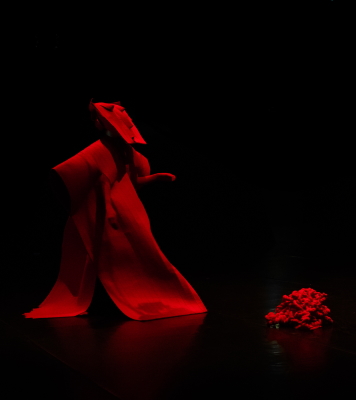August 16, 2019 by Veronica Posthhttps://www.seeingdance.com/plataforma-berlin-16082019/

Radial System, Dock11 and Verlin, Berlin
July 18-August 3, 2019
Veronica Posth
Over three weekends, Plataforma, an Ibero-American festival curated by Martha Hincapié Charry, created a platform that opened up a space for dialogue between nations and peoples. It also allowed for trans-disciplinary reflection as it shed a light on climate change, post-colonialism, the relationship between humans and nature, and the connection between art and nature.
The first evening opened with an enriching talk on climate breakdown and its repercussions, dance, activism, indigenous rights and threats by Carlos Castano Uribe, Sônia Guajajara and Denny Neves. Afterwards, the movie Hibridos, Spirits of Brasil by Priscilla Telmon and Vincent Moon, gave an interesting insight into Brazilian shamanic practices, helping understanding of a deeply spiritual and fascinating culture.

Photo LowGravity.pl/Plataforma Berlin 2019
The dance duet, El cuerpo vacio (The silent body) by Cuatro X Cuatro enhanced the evening still further. Performed by the brothers of Nadia Dominicque Vera Pérez, social anthropologist, murdered in 2015, the piece embodies anger, affliction, dissolution, disillusion, grief, rage, a ceaseless strength and positive, constructive revenge.
The two bodies begin with very small movements. A tiny, rundown bike has a container over the saddle into which the pair pour light blue acrylic. Their hands become covered with the same and disappear as the performance goes on. From almost invisible details they move on to powerful scattered runs across the stage. Sometimes they merge in precarious lifts, sometimes they hide behind the theatre curtains and slowly move them producing a sea wave of sound.
Unexpectedly they step and jump in unison. Numerous unforeseen moments create suspense enveloped in an amount of eclectic noises and strident voices. Something sinister is definitely happening. Although not fully revealed, a struggle is strongly suggested.
A soft and moving part comes towards the end when they float on an enchanting classical track as they try to grasp something invisible around them. It’s a moment of peaceful poetry in contrast to the previous thunder, before a closing catharsis thanks to guitar music played by one of the two.

Photo LowGravity.pl-Plataforma Berlin 2019
The second night saw the premiere of Hybris by La Quinta del Lobo. The title comes from Latin and means ‘bastard’ or ‘half-breed’. ‘Hybrid’ referred to the presumptuous disregard for the privacy of others, coupled with the inability to control one’s own impulses. Hybris was an insanity and a punishment of God.
Hybris is also a metaphor for human influence on the world. Although there have always been changes and hybridisations in nature, modern-day man-made mutations and metamorphoses have increased them, quickened the process, and created new landscapes and creatures.
The work captures well the forms of nature and artificiality. An enthralling futuristic set, beautiful costumes, evocative music and engaging videos make the piece a compelling experience. A hybrid being in an artificial igloo looks like an undefinable creature as it slowly awakens. Eventually, it transforms into a dancing devil; its metamorphoses in a gloomy part of the space bringing forth a being in red. The whole happening has influences of shamanistic practices; science and creativity generating an absorbing environment where to reflect on the tragical changes of our planet.
In Requiem for an Alcavaran by Lukas Avendaño puts on stage a brilliant interpretation of part of the culture of the indigenous Zapotec people, and reflects on gender images. The title comes from the soul of the dancer being embodied by a stone curlew (in Spanish, alcavaran).
It is a performative dance of man-woman. Homosexuality, gayness and same-sex marriage are part of indigenous Zapotec culture in the contradictory form of the ‘muxheidad’. A muxe is a man who takes on the affective, emotional and sexual roles that are culturally assigned to women. Muxheidad is a veiled form of acceptance and celebration of something that is still considered transgressive.
As Requiem for an Alcavaran unfolds, spectators are invited to take part in female, transitional rituals: the traditional wedding, the act of administration, the prayer of thanksgiving, mourning, and metamorphosis. There are no words, just a few delicate gestures to guide the unexpected performers.

Photo LowGravity.pl-Plataforma Berlin 2019
The colourful piece is a constant surprise as Lukas generates beautiful images and engaging moments. As it takes us to Mexico for an hour, it’s joyful, vibrant and bright.
Retrópica by talented Brazilian Mari Paula at Dock11 is a work of cultural anthropophagy. Containing Bossa nova, Flamenco and Samba flavours alongside stereotypical aspects of a woman’s daily routine, the work breaks the idea that a culture is hermetically sealed.
It’s a beautifully stratified work dealing with the eclectic aspects that define a woman. The metaphors Paula presents are interwoven with strength, charisma, savoir faire, beauty, self-confidence and irony, all merging together in a brilliant and entertaining way.
The final weekend saw Plataforma close with two significant and surprising pieces. In BIO, Tizo All starts by introducing himself and talks about percentage of animal and plant extinction asking the audience to repeat after him a couple of times, “This is happening right now.” As the atmosphere becomes more relaxed, he takes off his clothes and starts touching delicately his sculpted natural body.
Starting from the idea that human is nature, he shows his naked athletic body in hybrid forms, steps and sounds. As he moved, softly and animalistic through the courtyard of Verlin, followed by the audience, he approached the concepts and labels of biodiversity and biography by questioning those labels and fostering the need to unveil the truth.
All defines his work as practical anthropology and the result is excellent. With his smartly provocative show, he shakes the general scepticism and halts giggling reactions. ‘Manifesto homo sapiens’, he writes with clay on his body as he stares at people silently denouncing and deriding the paradox of the white male supremacy and the still present colonisation that such a phrase implies. Then he explodes in a copious laugh, suddenly stops and loudly yells, “It’s a joke!”
Striking, effective, powerful, the piece ends with him singing ‘Aquarela do Brasil’ by Ary Barroso waving at the spectators as they slowly leave to go into the theatre for the next show.
Back inside, Sin dar la cara das la cara by Kiko Faxas and Mr. Azúcar is a work in progress. As the audience enter, the two performers are already on stage casually YouTube zapping and playing with a synth. The piece starts with one playing ‘Here comes the sun’ by the Beatles on a ukulele while the other inflates a female doll. A fox and bunny mask are used at times, creating an obvious antagonism. References to Bad Bunny, Bugs Bunny, Playboy and Nestlé are all implied. A simulated video of Donald Trump singing ‘Havana’ by Camilla Cabello is played from YouTube, as well as videos about artificial intelligence and environmental issues that demonstrate the amount of information we all ingest every day.

Photo LowGravity.pl-Plataforma Berlin 2019 – Copy
A patchwork of absurdity is the first thing that comes to mind; not so much about the piece but about contemporary YouTube and social mass media.
Sin dar la cara das la cara is a stratified compendium of criticism towards the nowadays and the commonplace: superficiality versus content, insubstantial versus substance, ephemeral versus long-lasting. The whole piece reflects upon the algorithms we are constantly exposed to; on the manipulation and control of our data and privacy.
A quotation from Guy Debord’s critique of contemporary consumer culture and commodity fetishism, The Society of Spectacle: “The spectacle is not a collection of images, but a social relation among people, mediated by images,” is the ultimate sense of the piece.
A large cube of ice, used as a sensual element and embodying the only organic element on stage besides the two humans, inexorably melts. It’s a sharp reminded that humankind’s on-going actions have irreversible repercussions. They may be slow and silent, but they may well be ultimately disastrous.
Plataforma was a festival full of surprises, and full of detail about the Ibero-American political, social and environmental situation. It was eclectic and compelling; a festival about what is happening now, and one addressed to everyone who is curious and willing to explore the world.

Comments are closed.